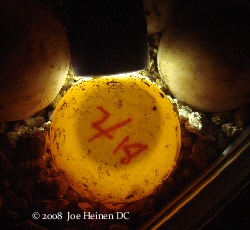Egg Laying and Development
Redfoot tortoises will lay eggs year round. However they seem to lay the most in the fall and early winter. They prefer very moist to rather wet locations. Mine frequently lay the eggs in muddy areas. Surprisingly the nest are usually rather shallow. Often the eggs are barely covered.
When nesting, the female often appears to be in a trance and takes little notice of activity around her. Nesting can take as long as 5 hours.
 |
 |
Redfoot Tortoises lay rather large round eggs. Clutch size ranges from 1-13 eggs. In my colony they usually lay 4-6 eggs. Egg size is variable and seems to be related to the size of the female and the number of eggs per clutch. They weigh 30-50 grams and are usually 40-45 mm in diameter.
I like to have an incubator set up prior to egg laying. I use the Hovabator. Its fairly cheap and keeps a constant temperature. An accurate digital max/min thermometer is a must. It can take a few days to get the temperature right. Most recommend the temperature to be set between 29°C (84.2°F) and 35°C (95°F). I have personally found that temps over 32.22°C (90°F) results in less hatchings. I prefer 30°C (86°F). Sex determination is temperature dependent, with lower temps producing males and higher temps producing females. At 31.67°C (89°F) I get females. If the temps are too high shell deformities (such as extra scutes) will occur.
Before digging up the eggs, set up a Tupperware container big enough to hold the eggs( you can see some examples below). Fill it half way with moist vermiculite (available at garden centers). To moisten the vermiculite , mix with an equal amount of water by weight.
Once the eggs are laid, carefully dig them up being sure not to rotate or flip them. I use a soft lead pencil to mark the date and weight on the top of the egg. Bury it half way in the vermiculite and cover with a damp piece of paper towel or some strands of damp sphagnum moss. Put the lid on loosely. In the incubator I put a few open containers of water. This helps keep the temps stable and helps with humidity. If all goes well they should hatch in 3-4 months.
Between 2-4 weeks blood vessels may be visible when candling. Candling is shining a bright light through the egg. Its best done in a dark room. Be careful not to turn the egg. Pictures below
Click on the picture to view full size
 At 5-8 days (depending on the temperature)chalking appears as a dark area. 2/24/2008 |
 The arrows point to the edge of the chalking at 7 days |
 When candled its easier to see. |
 2 days later the chalking is expanding. |
 Blood vessels visible to the left Laid 12/12/2007 picture 12/30/2007 |
|
 The embryo is the dark area to the right 12/30/2008 |
 same egg as above 1/03/2008 |
 This is from another clutch. This is at 22 days. This egg was laid on 2/05/2008 |
 This one hatched at 116 days. 03/01/2008 |
|
click here to see the embryo in motion Watch the dark area closely Another egg in the clutch 4 days later. click here |
|


